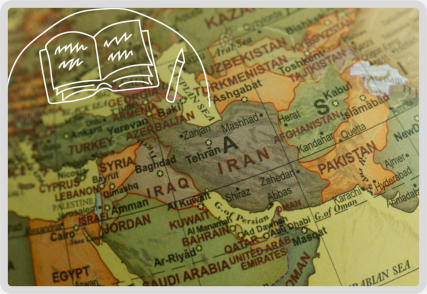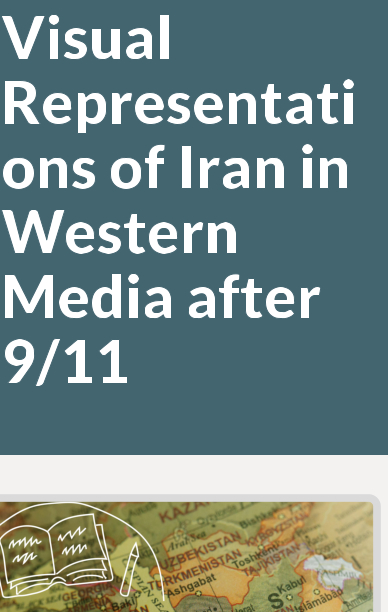

© 2023-2024 Oriental Institute, The Czech Academy of Sciences, Kevin L. Schwartz, and Ameem Lutfi


The
year
2001
has
been
considered
a
turning
point
in
the
rapid
increase
of
Islamophobia
and
Islamophobic
depic
-
tions
in
Western
media,
especially
concerning
Arab
and
Muslim
populations.
This
phenomenom
largely
stems
from
the
tragic
events
of
9/11
that
resulted
in
the
dissemination
of
the
ideology
of
the
Global
War
on
Terror.
While
ex
-
tensive
scholarship
and
research
has
examined
stereotypical
representations
of
Arabs
and
Muslims,
Iran
has
been
less
of
a
focus.
1
One
of
the
consequences
of
the
Iranian
Revolution
of
1979
was
the
consolidation
of
public
impres
-
sions
in
the
West
of
Iran
as
a
backward,
fanatical,
and
repressive
society.
2
Such
impressions
have
continued
in
Western
cinematography
in
the
post-9/11
era
by
depicting
Iran
as
a
fundamentalist
state
in
films
like
Not
Without
My
Daughter
or
The
Stoning
of
Soraya
M
,
and
television
series
propagating
the
War
on
Terror like
Homeland
or
24
.
In
order
to
examine
whether
Hollywood,
American
television,
and
independent
cinema
not
only
portray
Iran
and
its
people
in
an
Islamophobic
and
Iranophobic
manner
but
also
whether
such
portrayals
relate
to
U.S.
foreign
policy
actions
over
the
previous
twenty
years,
I
analyzed
fifteen
films
and
four
television
series
produced
between
2003-2019.
3
I
sought
to
analyze
the
ideology
of
these
films
and
TV
programs
on
the
micro-level
(e.g.
dialogue,
cultural
representations
of
Iran,
character
description,
and
plot
development)
as
well
as
the
macro-level
(e.g.
sociopolitical
context of the films’ narrative and production time, peak of negative representations, and differences between the conglomerate media industry and independent productions).
The
findings
of
my
ongoing
study
suggest
that
depictions
and
image
constructions
of
Iran
have
been
associated
in
the
collective
consciousness
of
American
culture
with
the
ideological
doctrine
of
the
clash
of
civilizations,
the
development
of
Iran’s
nuclear
facilities,
the
complicated
foreign
affairs
between
Iran,
the
U.S.,
and
Israel,
and
the
oil
crisis
of
1973.
A
significant
number
of
films
affiliate Iran and Islam with terrorism (
Homeland
,
Syriana
,
Argo
) and human rights violations (
The Stoning of Soraya M
).
Several
typical
examples
of
Iranphobia
in
Western
cinema
can
be
found
in
the
film
Argo,
which
depicts
the
1980
seizure
of
the
U.S.
embassy
in
Iran
and
won
multiple
Academy
Awards,
includ
-
ing
the
award
for
Best
Picture
presented
by
Michelle
Obama.
In
Argo,
there
is
no
context
explaining
the
motivations
of
the
Iranian
people
for
taking
over
the
U.S.
embassy.
Unlike
the
film’s
American
characters,
who
have
names,
family
or
community
bonds,
and
motives
for
their
actions,
Iranians
are
simply
portrayed
as
an
angry
mass
of
violent
men
and
chador-clad
women.
Nor
are
the
Persian
slogans
being
chanted
by
Iranians
translated
for
an
English-speaking
audience.
Yet,
when
an
element
of
the
story
appearing
in
Persian
is
deemed
important
to
the
advancement
of the plot (e.g. a threat or attack is imminent), an English translation is provided by the film’s American characters, who seem to command the language.
The
depiction
of
the
Iranian
state
in
other
artistic
productions
has
been
no
more
flattering.
In
Homeland
,
a
series
favored
by
Barack
Obama
and
Hilary
Clinton,
Iran
is
depicted
and
described
as
an
archterrorist
state
and
the
masterminds
behind
orchestrating
an
attack
on
CIA
premises
with
a
network
of
terrorists
resembling
al-Qaeda.
4
Even
when
Iran
is
not
directly
linked
to
terrorism,
images
of
violent
demonstrations
and
severe
state
oppression
predominate
in
films
like
Argo
and
a
series
like
Tehran
.
Elsewhere,
like
in
the
series
The
West
Wing
and
Veep,
Iran
is
depicted
as
a
faraway
place
stuck
in
the
past,
with
its
capital
city
Tehran
appearing
on
screen
as
a
technologically
underdeveloped
city,
indirectly
promoting
the
superiority
of
American
technological
achieve
-
ments.
5
All
these
images
shape
the
portrait
of
a
country
perceived
as
radicalized
or
backward
and,
most
importantly,
in
need
of
Western
intervention
to
progress.
Such
narratives
endorse
American soft power and a neocolonial view of Iran that helps legitimize U.S. foreign policy.
There
have
been
cinematic
and
television
portrayals
with
neutral
or
positive
Iranian
characters,
however,
these
usually
fall
under
the
category
of
post-racial
media
representations.
Such
repres
-
entations
include
Muslim
characters
compliant
with
Western
norms,
those
who
maintain
religious
practices
that
are
not
demonstrably
evident,
or
characters
depicted
as
victims
of
suffering
and
ridicule.
6
For
example,
in
the
third
season
of
Homeland,
Farah,
a
CIA
analyst
with
Iranian
heritage,
had
to
endure
ridicule
from
the
head
of
U.S.
Intelligence
Services
Saul
Berenson
for
wear
-
ing
a
hijab,
which
he
considered
an
insult
to
the
people
who
died
at
the
fictional
attack
on
the
CIA.
7
The
implication
is
that
had
Farah
not
worn
a
hijab,
her
presence
as
a
Muslim
would
have
been fully accepted due to the absence of any outward cultural display of her religion.
Many
positive
and
neutral
cinematic
or
television
portrayals
of
Iran
make
frequent
reference
to
the
Achaemenid
Empire
(550-330
BC)
and
their
great
kings,
like
Cyrus
and
Darius,
in
an
attempt
to
revive
the
dynasty’s
pre-Islamic
glory
and
differentiate
ancient
Persia
from
modern
Islamic
Iran.
For
example,
in
the
2015
film
September
of
Shiraz
,
a
prisoner
in
the
newly
formed
Islamic
Republic
wonders
if
anyone
remembers
the
time
when
the
country
was
governed
by
just
rulers,
to
which
another
replies:
“Cyrus
the
Great.
We
were
all
equal.
Muslim,
Christian,
Jew…didn’t
matter.
We
were
a
great
empire.”
Of
course
not
all
Hollywood
depictions
of
ancient
Persia
are
positive.
Films
like
300
(2006)
or
The
300
Spartans
(1962)
tend
to
present
Persia
as
a
totalitarian
empire
combating
Greece,
a
synecdoche
for
the
West,
who
is
seeking
to
preserve
the
ideals
of
freedom
and
democracy.
One
of
the
truly
rare
films
associating
Iran
and
its
people
with
positive
connotations
was
the
2019
film
The
Operative
,
which
addressed
issues
rarely
discussed
in
Western
cinema,
like
economic
sanctions
against
Iran
and
the
assassination
of
Iranian
nuclear
scientists.
While
negative
representations
of
Iran
increased
after
9/11,
it
is
worth
noting
that
the
peak
of
such
cinematic
portrayals
took
place
between
2005-2015,
that
is,
a
period
incorporating
only
three
years
of
the
Bush
presidency
and
nearly
the
entire
two
terms
of
Barack
Obama’s
presidency.
It
is
quite
possible
that
the
increase
in
Iranophobic
depictions
can
be
attributed
to
the
elec
-
tion
of
Mahmoud
Ahmadinejad
(2005-2013),
who
was
both
frequently
ridiculed
in
the
international
media
and
under
whose
presidency
Iran’s
nuclear
program
developed
significantly,
leading
to
a
spate
of
economic
sanctions
imposed
by
the
Obama
administration
and
the
European
Union.
Indeed,
the
majority
of
the
UN
Security
Council’s
resolutions
against
Iran
took
place
during
the
same
time
period
(2006-2015),
making
a
linkage
between
the
enforcement
of
economic
sanctions
against
Iran
and
the
country’s
negative
representations
by
the
Western
media
possible.
When
the
Iranian
nuclear
agreement
was
signed
in
2015,
and
economic
sanctions
began
to
drop,
the
more
biased
cinematic
portrayals
of
Iran
decreased,
demonstrating
once
again
that
the
image
construction
of
Iran
in
the
entertainment
industry
is
often
in-line
with
American
foreign
policy.
No
matter
its
ebbs
and
flows,
cinematic
and
media
representations
of
Iran
must
be
viewed
critically.
They
have
the
potential
to
shape
public
opinion
by
reflecting
the
political
stimuli
of
a
certain
era
or
by
propagating
favored
government
policies,
thereby
acting
as
agents
of
soft
power.






If you are interested in contributing an article for
the project, please send a short summary of the
proposed topic (no more than 200 words) and brief
bio to submissions@911legacies.com. For all
other matters, please contact
inquiry@911legacies.com.

CONTACT


The
year
2001
has
been
considered
a
turning
point
in
the
rapid
increase
of
Islamophobia
and
Islamophobic
depictions
in
Western
media,
es
-
pecially
concerning
Arab
and
Muslim
popula
-
tions.
This
phenomenom
largely
stems
from
the
tragic
events
of
9/11
that
resulted
in
the
dissem
-
ination
of
the
ideology
of
the
Global
War
on
Terror.
While
extensive
scholarship
and
research
has
examined
stereotypical
representations
of
Arabs
and
Muslims,
Iran
has
been
less
of
a
focus.
1
One
of
the
consequences
of
the
Iranian
Revolution
of
1979
was
the
consolidation
of
pub
-
lic
impressions
in
the
West
of
Iran
as
a
backward,
fanatical,
and
repressive
society.
2
Such
impres
-
sions
have
continued
in
Western
cinemato
-
graphy
in
the
post-9/11
era
by
depicting
Iran
as
a
fundamentalist
state
in
films
like
Not
Without
My
Daughter
or
The
Stoning
of
Soraya
M
,
and
television
series
propagating
the
War
on
Terror
like
Homeland
or
24
.
In
order
to
examine
whether
Hollywood,
American
television,
and
independent
cinema
not
only
portray
Iran
and
its
people
in
an
Islamophobic
and
Iranophobic
manner
but
also
whether
such
portrayals
relate
to
U.S.
foreign
policy
actions
over
the
previous
twenty
years,
I
analyzed
fifteen
films
and
four
television
series
produced
between
2003-2019.
3
I
sought
to
ana
-
lyze
the
ideology
of
these
films
and
TV
programs
on
the
micro-level
(e.g.
dialogue,
cultural
repres
-
entations
of
Iran,
character
description,
and
plot
development)
as
well
as
the
macro-level
(e.g.
so
-
ciopolitical
context
of
the
films’
narrative
and
production
time,
peak
of
negative
representa
-
tions,
and
differences
between
the
conglomer
-
ate
media
industry
and
independent
productions).
The
findings
of
my
ongoing
study
suggest
that
depictions
and
image
constructions
of
Iran
have
been
associated
in
the
collective
consciousness
of
American
culture
with
the
ideological
doctrine
of
the
clash
of
civilizations,
the
development
of
Iran’s
nuclear
facilities,
the
complicated
foreign
affairs
between
Iran,
the
U.S.,
and
Israel,
and
the
oil
crisis
of
1973.
A
significant
number
of
films
affiliate
Iran
and
Islam
with
terrorism
(
Homeland
,
Syriana
,
Argo
)
and
human
rights
vi
-
olations (
The Stoning of Soraya M
).
Several
typical
examples
of
Iranphobia
in
Western
cinema
can
be
found
in
the
film
Argo,
which
depicts
the
1980
seizure
of
the
U.S.
em
-
bassy
in
Iran
and
won
multiple
Academy
Awards,
including
the
award
for
Best
Picture
presented
by
Michelle
Obama.
In
Argo,
there
is
no
context
explaining
the
motivations
of
the
Iranian
people
for
taking
over
the
U.S.
embassy.
Unlike
the
film’s
American
characters,
who
have
names,
family
or
community
bonds,
and
motives
for
their
actions,
Iranians
are
simply
portrayed
as
an
angry
mass
of
violent
men
and
chador-clad
women.
Nor
are
the
Persian
slogans
being
chanted
by
Iranians
translated
for
an
English-
speaking
audience.
Yet,
when
an
element
of
the
story
appearing
in
Persian
is
deemed
important
to
the
advancement
of
the
plot
(e.g.
a
threat
or
attack
is
imminent),
an
English
translation
is
provided
by
the
film’s
American
characters,
who
seem to command the language.
The
depiction
of
the
Iranian
state
in
other
artistic
productions
has
been
no
more
flattering.
In
Homeland
,
a
series
favored
by
Barack
Obama
and
Hilary
Clinton,
Iran
is
depicted
and
described
as
an
archterrorist
state
and
the
masterminds
behind
orchestrating
an
attack
on
CIA
premises
with
a
network
of
terrorists
resembling
al-
Qaeda.
4
Even
when
Iran
is
not
directly
linked
to
terrorism,
images
of
violent
demonstrations
and
severe
state
oppression
predominate
in
films
like
Argo
and
a
series
like
Tehran
.
Elsewhere,
like
in
the
series
The
West
Wing
and
Veep,
Iran
is
de
-
picted
as
a
faraway
place
stuck
in
the
past,
with
its
capital
city
Tehran
appearing
on
screen
as
a
technologically
underdeveloped
city,
indirectly
promoting
the
superiority
of
American
technolo
-
gical
achievements.
5
All
these
images
shape
the
portrait
of
a
country
perceived
as
radicalized
or
backward
and,
most
importantly,
in
need
of
Western
intervention
to
progress.
Such
narrat
-
ives
endorse
American
soft
power
and
a
neoco
-
lonial
view
of
Iran
that
helps
legitimize
U.S.
foreign policy.
There
have
been
cinematic
and
television
por
-
trayals
with
neutral
or
positive
Iranian
charac
-
ters,
however,
these
usually
fall
under
the
category
of
post-racial
media
representations.
Such
representations
include
Muslim
characters
compliant
with
Western
norms,
those
who
main
-
tain
religious
practices
that
are
not
demon
-
strably
evident,
or
characters
depicted
as
victims
of
suffering
and
ridicule.
6
For
example,
in
the
third
season
of
Homeland,
Farah,
a
CIA
analyst
with
Iranian
heritage,
had
to
endure
ridicule
from
the
head
of
U.S.
Intelligence
Services
Saul
Berenson
for
wearing
a
hijab,
which
he
con
-
sidered
an
insult
to
the
people
who
died
at
the
fictional
attack
on
the
CIA.
7
The
implication
is
that
had
Farah
not
worn
a
hijab,
her
presence
as
a
Muslim
would
have
been
fully
accepted
due
to
the
absence
of
any
outward
cultural
display
of
her religion.
Many
positive
and
neutral
cinematic
or
televi
-
sion
portrayals
of
Iran
make
frequent
reference
to
the
Achaemenid
Empire
(550-330
BC)
and
their
great
kings,
like
Cyrus
and
Darius,
in
an
at
-
tempt
to
revive
the
dynasty’s
pre-Islamic
glory
and
differentiate
ancient
Persia
from
modern
Islamic
Iran.
For
example,
in
the
2015
film
September
of
Shiraz
,
a
prisoner
in
the
newly
formed
Islamic
Republic
wonders
if
anyone
re
-
members
the
time
when
the
country
was
gov
-
erned
by
just
rulers,
to
which
another
replies:
“Cyrus
the
Great.
We
were
all
equal.
Muslim,
Christian,
Jew…didn’t
matter.
We
were
a
great
empire.”
Of
course
not
all
Hollywood
depictions
of
ancient
Persia
are
positive.
Films
like
300
(2006)
or
The
300
Spartans
(1962)
tend
to
present
Persia
as
a
totalitarian
empire
combating
Greece,
a
synecdoche
for
the
West,
who
is
seek
-
ing
to
preserve
the
ideals
of
freedom
and
demo
-
cracy.
One
of
the
truly
rare
films
associating
Iran
and
its
people
with
positive
connotations
was
the
2019
film
The
Operative
,
which
addressed
is
-
sues
rarely
discussed
in
Western
cinema,
like
economic
sanctions
against
Iran
and
the
assas
-
sination of Iranian nuclear scientists.
While
negative
representations
of
Iran
increased
after
9/11,
it
is
worth
noting
that
the
peak
of
such
cinematic
portrayals
took
place
between
2005-2015,
that
is,
a
period
incorporating
only
three
years
of
the
Bush
presidency
and
nearly
the
entire
two
terms
of
Barack
Obama’s
presid
-
ency.
It
is
quite
possible
that
the
increase
in
Iranophobic
depictions
can
be
attributed
to
the
election
of
Mahmoud
Ahmadinejad
(2005-2013),
who
was
both
frequently
ridiculed
in
the
interna
-
tional
media
and
under
whose
presidency
Iran’s
nuclear
program
developed
significantly,
leading
to
a
spate
of
economic
sanctions
imposed
by
the
Obama
administration
and
the
European
Union.
Indeed,
the
majority
of
the
UN
Security
Council’s
resolutions
against
Iran
took
place
during
the
same
time
period
(2006-2015),
making
a
linkage
between
the
enforcement
of
economic
sanctions
against
Iran
and
the
country’s
negative
repres
-
entations
by
the
Western
media
possible.
When
the
Iranian
nuclear
agreement
was
signed
in
2015,
and
economic
sanctions
began
to
drop,
the
more
biased
cinematic
portrayals
of
Iran
de
-
creased,
demonstrating
once
again
that
the
image
construction
of
Iran
in
the
entertainment
industry
is
often
in-line
with
American
foreign
policy.
No
matter
its
ebbs
and
flows,
cinematic
and
media
representations
of
Iran
must
be
viewed
critically.
They
have
the
potential
to
shape
public
opinion
by
reflecting
the
political
stimuli
of
a
certain
era
or
by
propagating
favored
government
policies,
thereby
acting
as
agents
of
soft power.
© 2023-2024 Oriental Institute, The Czech Academy of
Sciences, Kevin L. Schwartz, and Ameem Lutfi


Written by




If you are interested in contributing an article for the
project, please send a short summary of the proposed
topic (no more than 200 words) and brief bio to
submissions@911legacies.com. For all other
matters, please contact inquiry@911legacies.com.

CONTACT


















